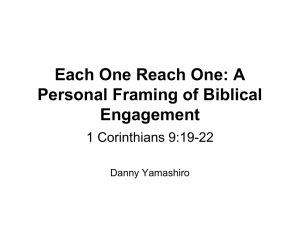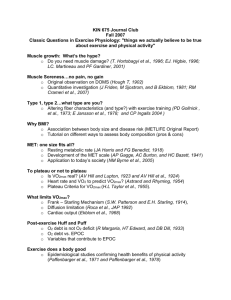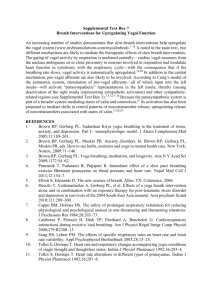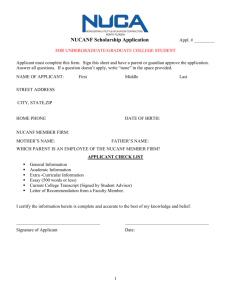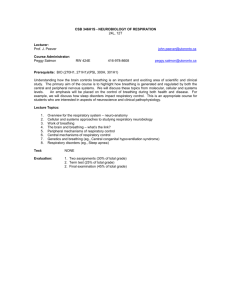CURRICULUM VITAE - USC - Viterbi School of Engineering
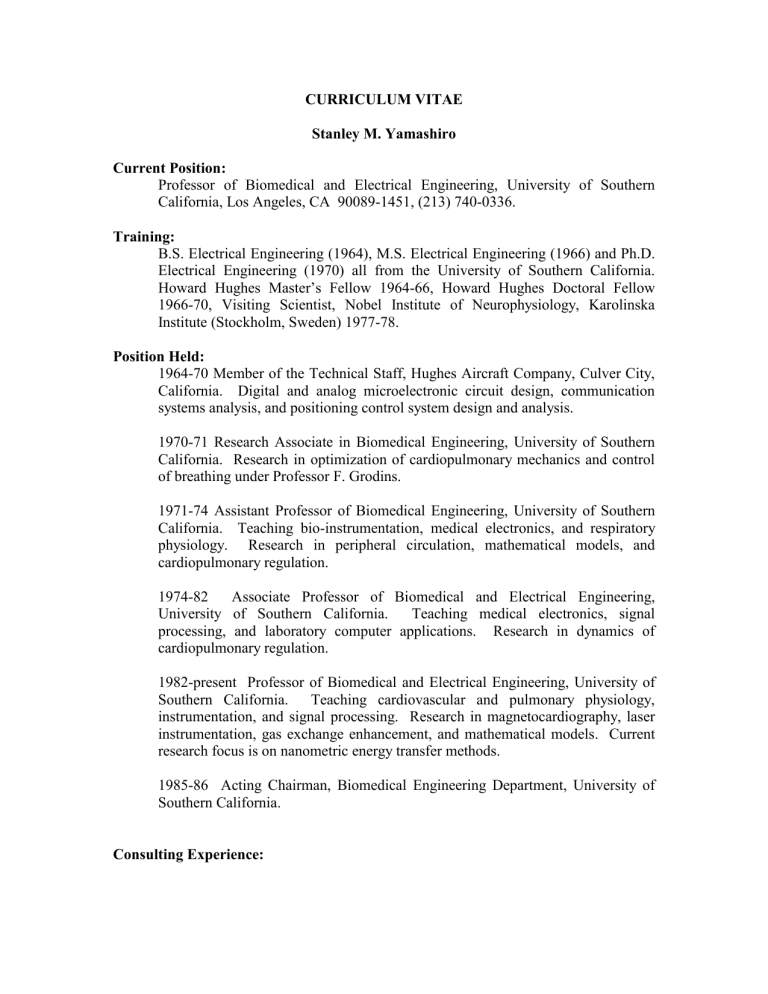
CURRICULUM VITAE
Stanley M. Yamashiro
Current Position:
Professor of Biomedical and Electrical Engineering, University of Southern
California, Los Angeles, CA 90089-1451, (213) 740-0336.
Training:
B.S. Electrical Engineering (1964), M.S. Electrical Engineering (1966) and Ph.D.
Electrical Engineering (1970) all from the University of Southern California.
Howard Hughes Master’s Fellow 1964-66, Howard Hughes Doctoral Fellow
1966-70, Visiting Scientist, Nobel Institute of Neurophysiology, Karolinska
Institute (Stockholm, Sweden) 1977-78.
Position Held:
1964-70 Member of the Technical Staff, Hughes Aircraft Company, Culver City,
California. Digital and analog microelectronic circuit design, communication systems analysis, and positioning control system design and analysis.
1970-71 Research Associate in Biomedical Engineering, University of Southern
California. Research in optimization of cardiopulmonary mechanics and control of breathing under Professor F. Grodins.
1971-74 Assistant Professor of Biomedical Engineering, University of Southern
California. Teaching bio-instrumentation, medical electronics, and respiratory physiology. Research in peripheral circulation, mathematical models, and cardiopulmonary regulation.
1974-82 Associate Professor of Biomedical and Electrical Engineering,
University of Southern California. Teaching medical electronics, signal processing, and laboratory computer applications. Research in dynamics of cardiopulmonary regulation.
1982-present Professor of Biomedical and Electrical Engineering, University of
Southern California. Teaching cardiovascular and pulmonary physiology, instrumentation, and signal processing. Research in magnetocardiography, laser instrumentation, gas exchange enhancement, and mathematical models. Current research focus is on nanometric energy transfer methods.
1985-86 Acting Chairman, Biomedical Engineering Department, University of
Southern California.
Consulting Experience:
1971-76 Rancho Los Amigos Hospital, Downey, California, Environmental
Health Department, consultant for on-line computer processing of human subject pulmonary function test data collected during controlled pollutant exposure.
1976-1977 Valley Presbyterian Hospital, Van Nuys, California, Respiratory Care
Department, computer consultant on on-line patient pulmonary function testing and blood-gas analysis. Developed an automated blood gas diagnosis and data base management program
1979 Bentley Laboratories, Irvine, California, consultant on instrumentation for synchronous detection of electrical conductivity of blood to permit cardiac output measurement.
1980 National Institutes of health, consultant on computer information processing, storage and retrieval, site visit team member (HL 20609-3).
1993-1996 Department of Cardiothoracic Surgery, Children's Hospital Los
Angeles, Vaughn Starnes, M.D., Chairman, computer and instrumentation consultant on lung transplantation research in animals. Developed an on-line monitoring and physiological testing program in Visual Basic.
1997 Medtronic, Inc., Cardiopulmonary Division, consultant on mathematical modeling of temperature and blood gas changes associated with cardiopulmonary bypass oxygenators. Developed an interactive Visual Basic (Windows 95) program as an aid to perfusionists.
1998-2000 Baxter Healthcare Corp., consultant on mathematical modeling of oxygenation, temperature, and blood flow during cardiopulmonary bypass.
Developed three interactive programs for use as a training aid for perfusionists.
An interactive blood flow simulator was also used in developing a new vacuum assisted venous return product. A CD Rom version of this simulator is currently used as a marketing device for this new product.
Professional Societies:
Member: American Physiological Society, Biomedical Engineering Society,
Sigma Xi, Eta Kappa Nu, Tau Beta Pi (chapter advisor). Member, Editorial
Board, American Journal of Physiology and Journal of Applied Physiology,
Modeling Methodology Section
Grant Experience
Quallion /Alfred Mann Institute DNA Nanometiric Power Source
$34,000, 1 January 2002 to April 1 2002
Alfred Mann Institute Magnetic Plethysmography for Respiratory Mesurements
$150,000, 1 June 2001 to Aug 2007.
NSF Transcutaneous Laser Doppler Measurement of Mucus Clearance
$20,000, 1 June 1998 to 31 May 1999.
Previous
1) NIH Training - Cardiopulmonary Biomedical Engineering
S.M. Yamashiro, P.I.
HL-33274 (8years)
2) NIH RO1-Cardiopulmonary Control Coupling
S.M. Yamashiro, P.I.
HL-16390
1 April 1988 to 31 March 1994(18 years )
Principal Investigator of two other RO1 NIH grants and one NSF grant. Co-Investigator in one NIH program project grant(with F.S. Grodins, M.D., Ph.D.-8years), and four other
NIH center grants(with : F.E. Yates, M.D.-Biomedical Engineering Center,J.D. Hackney,
M.D.-Specialized Center of Research-Environmental Lung Disease, J.
Bassingthewaighte, M.D.-Biomedical Simulation Resource(Seattle), and V. Marmarelis,
Ph.D.-Biomedical Simulation Resource(USC))
Publications
1. Sato, T., S.M. Yamashiro and F.S. Grodins, Measurement of peripheral vascular properties by a frequency response method , Am. J. Physiol. 200 (1971), 1640.
2. Yamashiro, S.M. and F.S. Grodins, Optimal regulation of respiratory airflow , J.
Appl. Physiol. 30 9171), 597.
3. Yamashiro, S.M. and F.S. Grodins, Respiratory cycle optimization in exercise , J.
Appl. Physiol. 35 (1973), 522.
4. Grodins, F.S. and S.M. Yamashiro, Optimization of the mammalian respiratory gas transport system , Ann. Rev. Biophysics & Bioengineering. 2 (1973), 115.
5. Yamashiro, S.M., S.K. Karuza and J.K. Hackney, Phase compensation of Fleisch pneumotachographs , J. Appl. Physiol. 36 (1974), 493.
6. Sato, T., S.M. Yamashiro, D. Vega and F.S. Grodins, Parameter sensitivity analysis of a network model of systemic circulatory mechanics , Ann. Biomed. Eng. 2 (1974),
289.
7. Yamashiro, S.M., J.A. Daubenspeck, T.N. Lauritsen and F.S. Grodins, Total work rate of breathing optimization in CO2 inhalation and exercise , J. Appl. Physiol. 38
(1975), 702.
8. Sato, T., S.M. Yamashiro, and F.S. Grodins, Dynamic analysis of gravimetric response of isolated dog hindlimb , Am. J. Physiol. 228 (1975), 1326.
9. Bekey, G.A. and S.M. Yamashiro, Parameter estimation in mathematical models of biological systems , Adv. in Biomed. Engr. 6 (1976), 1.
10. Grodins, F.S. and S.M. Yamashiro, Respiratory Function of the Lung and its
Control , MacMillan, New York, 1978.
11. Yamashiro, S.M., J.A. Daubenspeck, F.M. Bennett, S.K. Edelman and F.S. Grodins,
Optimal control analysis of left ventricular ejection. In: Cardiovascular System
Dynamics , Eds. J. Baan, A. Noordergraaf and J. Raines, MIT Press, Cambridge,
1978, pp. 427-431.
12. Bruce, E.M., C. vonEuler and S.M. Yamashiro, Reflex and central chemoreceptive control of the time course of inspiratory activity. In: Central Nervous Control
Mechanisms in Breathing , Eds. C. vonEuler and H. Lagercrantz, Pergamon Press,
Oxford, 1979, pp.177-184.
13. Grodins, F.S. and S.M. Yamashiro, What is the pattern of breathing regulated for.
In: Central Nervous Control Mechanisms in Breathing , Eds, C. vonEuler and H.
Lagercrantz, Pergamon Press, Oxford, 1979, pp. 169-175.
14. Yamashiro, S.M., J.A. Daubenspeck and F.M. Bennett, Optimal regulation of left ventricular ejection pattern , Appl Math. and Comp 5 (1979), 41-54.
15. Bennett, F.M., P. Reischl, F.S. Grodins, S.M. Yamashiro and W.E. Fordyce,
Identification of ventilatory dynamics using pseudorandom binary sequences ,
Trans. inst. Measurement & Control (U.K.) 2 (1980), 20-24.
16. Sato, Toshiro, M. Shiratake, N. Ikeda, D. Vega, S.M. Yamashiro and F.S. Grodins,
Hemodynamic Parameters of the Isolated Dog Kidney as Determined by a
Frequency Response Method , Japanese Journal of Physiology 30 91980), 393-413.
17. Sohrab, S. and S.M. Yamashiro, Pseudo-Random testing of ventilatory response to inspired CO2 in man , J. Appl. Physiol. 40 (1980), 1000-1009.
18. Livnat, A. and S.M. Yamashiro, Optimal Control Evaluation of Left Ventricular
Systolic Dynamics , Am. J. Physiol. 240 (1981), R370-R383.
19. Bennett, F.M., P. Reischl, F.S. Grodins, S.M. Yamashiro and W.E. Fordyce,
Dynamics of the ventilatory response to exercise in man , J. Appl. Physiol. 51
(1981), 194-203.
20. Bruce, E.M., C. vonEuler, J.R. Romaniuk and S.M. Yamashiro, Vagal afferent effects on the intensity of phrenic nerve discharge , Acta Physiol. Scand. 116 (1982),
351-362.
21. Yamashiro, S.M., Influence of central respiratory activity dynamics on pattern regulation. In: Modeling and Control of Breathing , Eds. B. Whipp and D.M.
Wiberg, Elsevier, New York, 1983, pp. 115-119.
22. Yamashiro, S.M. and S. Ghazanshahi, Ventilatory CO2 responses during hypocapnia in anesthetized cats , J. Appl. Physiol.: Respirat. Environ. Exercise
Physiol. 56 91984), 678-680.
23. Ghazanshahi, S.D., S.M. Yamashiro and V.Z. Marmarelis, Use of a random forcing for high frequency ventilation , J. Appl. Physiol. 62 (1987), 1201-1205.
24. Ghazanshahi, S.D., V.Z. Marmarelis and S.M. Yamashiro, Analysis of the gas exchange system during high frequency ventilation , Annals of Biomedical
Engineering 14 (1986), 525-542.
25. Cha, E.J., D. Sedlock and S.M. Yamashiro, changes in lung volume and breathing pattern during exercise and CO2 inhalation in humans , J. Appl. Physiol. 62 (1987),
1544-1550.
26. Lin, C.K., H. Levenson and S.M. Yamashiro, Optimization of coronary blood flow during cardiopulmonary resuscitation , IEEE Trans. on BME BME-34 (1987), 473-
481.
27. Hwang, W.W., S.M. Yamashiro, D. Sedlock and F.S. Grodins, Ventilatory response to CO2 and O2 near eupnea in awake dogs , J. Appl. Physiol., 65: 788-796, 1988.
28. E.J. Cha, E. Chow, D.M. Vega, and S.M. Yamashiro. Automated temperature control system for vagal cooling . J. Appl. Physiol. 65:469-472, 1988.
29. E. Chow, E.J. Cha, and S.M. Yamashiro. Ventilatory responses to increased blood flow and lowered lung volume in awake dogs . J. Appl. Physiol. 65:714-720, 1988.
30. E.J. Cha, E. Chow, H.K. Chang, and S.M. Yamashiro. Lung hyperinflation in isolated dog lungs during high frequency oscillation (HFO) . J. Appl. Physiol.
65:1172-1179, 1988.
31. Khoo, M.C.K., S.M. Yamashiro, and P. Yamashiro. Minimization of lung pressure swings during high-frequency ventilation: a model . J. Appl. Physiol. 67:993-1000,
1989.
32. Yamashiro, S.M. and F.S. Grodins. Consequences of lung volume optimization on exercise hyperpnea. In: Modeling and Parameter Estimation in Respiratory
Control . Ed. M.C.K. Khoo, Plenum, New York, 1990.
33. Yamashiro, S.M. Distinguishing random from chaotic breathing pattern behavior.
In: Modeling and Parameter Estimation in Respiratory Control . Ed. M.C.K.
Khoo, Plenum, New York, 1990.
34. Yamashiro, S.M., D.W. Slaaf, R.S. Reneman, G.J. Tangelder, and J.B.
Bassingthewaighte. Fractal analysis of vasomotion. Ann. N.Y. Acad. Sci. 591:
410-416, 1990.
35. Glenny, R.W., H.T. Robertson, S.M. Yamashiro, and J.B. Bassingthewaighte.
Applications of fractal analysis to physiology . J. Appl. Physiol. 70:2351-2367,
1991.
36. Yamashiro, S.M., C.S, Poon, and J.J. DiStefano III. Modeling pioneer: Fred S.
Grodins (1915-1989). J.Appl. Physiol. 70: 1080-1081, 1991.
37.Yamashiro, S.M., P.K. Yamashiro, R.W. Glenny, and H.T. Robertson. Nonlinear dynamics of cardiopulmonary responses during exercise.
In: Control of Breathing and its Modeling Perspective. eds. Y. Honda, Y. Miyamoto, K. Konno, and J.G.
Widdicombe, Plenum, New York, 1992 .
38. Yamashiro, S.M. Uniqueness of optimal controllers during exercise.
Annals of Biomed. Eng. 21: 531-535, 1993
39. Yamashiro, S.M., G.A. Taylor, S.K.M. Luk, and R.E. Kalaba. Automated solutions
of breathing pattern optimizations.
Computers and Mathematics with Applications
. 27: 155-161, 1994.
40. Kawaoka, P.Y. and S.M. Yamashiro. Separation of cardiac conduction system and atrial activities by spatial regression . Med. Eng. Phys. 18: 45-50, 1996.
41 Yamashiro, S.M. Interactive Cardiopulmonary Bypass Model. Baxter Healthcare,
CD Rom version, 2000.
42. Yamashiro, S.M. Supraspinal locomotor centers do/do not contribute significantly to the hypernea of dynamic exercise. J. Appl. Physiol. 100: 1744, 2006.
43. Yamashiro, S.M. Non-linear dynamics of human periodic breathing and implications for sleep apnea therapy. Med. Bio. Eng. Comput. 45: 345-356, 2007.
.
